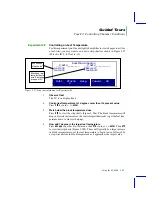
Guided Tours
Tour #3: Controlling Chamber Conditions
Using the LI-6400
3-23
sample (
H2OS_mml
) will increase as well, but not as much, since the paper
is not able to evaporate as much water into the more humid air.
7
Change to a low flow rate: 100 µmol s
-1
.
Press
F2
then type
100
. (Notice the short cut: when you arenÕt changing con-
trol
modes
, you can just start typing the target value after you press the func-
tion key. In our case, we didnÕt need to press
F
again to specify fixed flow
mode.)
8
Note the sample and reference humidities
The reference value hasnÕt changed, but the sample value increased, because
the air is going through the chamber at a much slower rate, thereby having a
longer exposure to the evaporating paper. In fact, you may start getting ÒHigh
Humidity AlertÓ flashing on the center line of the display. If it does, ignore it.
(Warning messages are discussed later, on page 3-26.)
9
Turn the desiccant to full scrub
Observe that the reference and sample humidities fall, and note that a) the
sample value comes down slowly because of the slow flow rate
4
, and b) the
reference goes back to near zero, but c) the sample doesnÕt return to the value
you had in Step 4, because now the flow is slower.
Fixed Humidity Operation
One of the powerful features of the LI-6400 is itÕs ability to operate in a fixed
humidity mode. It does this by actively regulating the flow rate to maintain a
4.
If you have a CO
2
mixer, the reference value will decrease rapidly, because Òex-
cessÓ flow is routed to the reference line (Figure 1-2 on page 1-5).
Points to Remember
¥ At equilibrium, reference humidity is determined solely by the desiccant
tube scrub setting; it doesnÕt depend on flow rate.
¥ At equilibrium, sample humidity is determined by
a) desiccant tube scrub setting
b) flow rate
c) evaporation from the leaf.
¥ The lowest chamber humidities are achieved by high flow and full scrub-
bing, and the highest by low flow and not scrubbing. Between these limits,
any chamber humidity can be achieved by various combinations of flow
rate and scrub setting. (For a picture of this, see Figure 3-39 on page 3-47.)
Summary of Contents for LI-6400
Page 1: ...Using the LI 6400 Portable Photosynthesis System ...
Page 15: ...Part I The Basics ...
Page 16: ......
Page 174: ...Making Measurements Answers to Questions 4 56 Using the LI 6400 4 ...
Page 175: ...Part II Useful Details ...
Page 176: ......
Page 200: ...Standard Tools Power ON Hooks 5 24 Using the LI 6400 5 ...
Page 214: ...Real Time Data Real Time Graphics 6 14 Using the LI 6400 6 ...
Page 234: ...Environmental Control Light Control 7 20 Using the LI 6400 7 ...
Page 244: ...Light Sensor Considerations Gallium Arsenide Phosphide GaAsP Sensor 8 10 Using the LI 6400 8 ...
Page 288: ...Data Logging Making Your Own AutoPrograms 9 44 Using the LI 6400 9 ...
Page 289: ...Part III Working With Files ...
Page 290: ......
Page 312: ...The LPL File System Troubleshooting 10 22 Using the LI 6400 10 ...
Page 340: ...Downloading Files Using a Data Capture Program 11 28 Using the LI 6400 11 ...
Page 375: ...Part IV Configuration Issues ...
Page 376: ......
Page 420: ...Defining User Variables Old Style vs New Style 15 18 Using the LI 6400 15 ...
Page 454: ...Using an Energy Balance Further Reading 17 12 Using the LI 6400 17 ...
Page 455: ...Part V Maintenance Troubleshooting ...
Page 456: ......
Page 572: ...Troubleshooting Useful Information 20 46 Using the LI 6400 20 ...
Page 593: ...Part VI Programming ...
Page 594: ......
Page 622: ...Programming with LPL Compiler Directives 22 28 Using the LI 6400 22 ...
Page 846: ...Index I 16 Using the LI 6400 ...






























